
Big Cataloochee -- only fragments remain of the once-thriving community of Cataloochee; bits and pieces that serve to remind us of what life here was like. This was the biggest settlement in the Smokies. At the turn of the century, nearly 200 buildings were scattered around the picturesque cove. Only a handful are left.
People were pushed into the Cataloochee Valley as older settlements on the outside became more crowded, and family holdings were subdivided among heirs to their smallest limits. Young adults had to go somewhere else to start a homestead. All of the valley once belonged to Colonel Robert Love, a post-Revolutionary War land speculator who granted homesteads to those who would settle and improve the land.
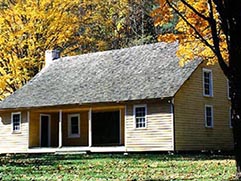 |
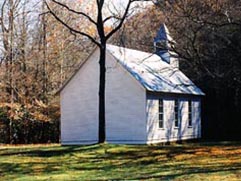 |
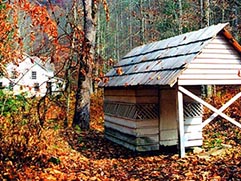 |
Palmer House |
Palmer Chapel | Woody House |
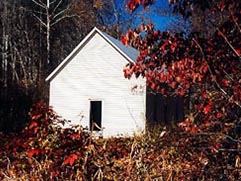 |
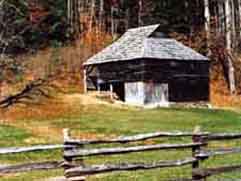 |
 |
| Beech Grove School | Messer Barn | Cataloochee Cemetery |
| Above images courtesy of Richard Messer. | ||
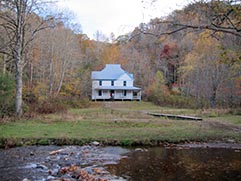 |
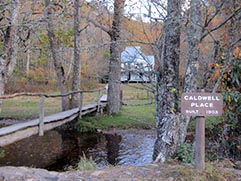 |
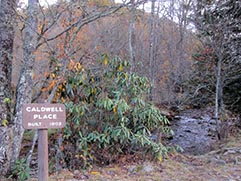 |
| Caldwell Place | Caldwell Place | Caldwell Place |
The earliest known entries on this part of the Love estate were made by the Caldwells (1814), followed by the Hannah, Bennet, Noland, Palmer, Franklin, Woody, and Barnes families. By the 1950s Cataloochee was well-populated, but not full.
The U.S. agricultural census shows a steady increase in property values and livestock and crop production. Much of the produce went to outside markets in Tennessee and the Carolinas. Big and Little Cataloochee were becoming communities in their own right, no longer mere outposts of older ones.
Will Messer Barn
Built by Will Messer about 1904-1905, this barn stood on his farm in Little Cataloochee. It was moved here and restored in 1977 because the forest had overgrown the original site. It is typical of many such outbuildings that once clung to the hillsides of Big and Little Cataloochee.
Palmer Chapel
Religion entered Cataloochee with the Indians, but the white settlers preferred their own brand. Land for this Methodist Church was deeded by Mary Ann Palmer in 1898, and the building went up in the same year. Preachers were supplied by the Western North Carolina Conference of the Methodist Episcopal Church. Most of them were circuit riders who visited about one Sunday each month. Services consisted of prayers, singing and sermons. Revivals held each fall rekindled the spirits of the faithful and brought in new members.
Even today a reunion is held each year at the church. Friends and families return to clean the cemeteries, attend services and have dinner on the grounds.
Beech Grove School
As the wilderness gave way to settlement, Cataloocheans provided schooling for their children. Although there were others, this school building is the only one left in the valley today.
The school was built in 1901 to replace an older log building. Schooling followed the laws and curriculum prescribed by the state. By the 1920s the term varied, but normally it ran from November through January. If sufficient local funds could be collected (subscriptions), it continued through February and March.
Beech Grove School
School began at 8 a.m. and let out at 4 p.m. with two recesses and a lunch hour. Children usually ate in family groups, the older ones being in charge of the little ones. The lunch bucket was usually jammed with sweet potatoes, cornbread, beans, applesauce, biscuits, ham, and a jar or milk.
Subject matter included reading, writing, spelling, arithmetic, geography, and grammar. Friday was parents' day. They came in the afternoon to see what the children had accomplished that week. Spelling bees, recitations and singing were both a test and an outlet for the pupils' pride.
School days ended in Cataloochee soon after the Park was established. Relocation of families to communities outside left the desks empty, the blackboard dusty, and the building a lot quieter than it used to be.
Caldwell House
Hiram Caldwell and his family lived for a long time in the old Levi Caldwell log house here on Rough Fork. In 1903 he decided it was time for a new home. Typical of houses to come, his new place (completed in 1906) was a modern framed structure with weatherboarding, as well as interior panelling imported from Waynesville. The shingled gables reflected the nationally-popular Eastlake style of the day. Hiram's stylish home was comfortable and its beauty enhanced by handmade furniture from Cosby, Tennessee.
Old traditions persisted in the new home. The warping and quilting frames, spinning wheel and loom stood ready upstairs. The family's sheep yielded wool that padded quilts, was woven into cloth, or traded for goods on the open market. While the women did their household chores, the men and boys farmed and managed livestock on the high mountain pastures.
By the 20th century, isolation and solitude were things of the past in Cataloochee and in the Caldwell home. Family life, business affairs, tourists, and renters added variety and interest to the daily routines.
Woody House
This home began as a one-room log cabin. Jonathan Woody entered Cataloochee before the Civil War, moved out for a while, and returned around 1866. He, a widower, and his new wife, a widow, brought his children and her children. This increased the population of Cataloochee substantially and abruptly. By 1900 or so it was necessary to enlarge the Woody cabin. The framed additions, including several bedrooms, porches, and a kitchen, were built from 1901-1910.
Steve Woody was now head of the household, father Jonathan having died in 1894. All eight kids slept upstairs in the "old soldiers' room" and awoke each morning to the sound of their mother grinding coffee. The usual farm and household work was relieved by supplemental tasks: gathering chestnuts, robbing beehives, hunting, and trapping.
Like many Cataloochee families, the Woodys took advantage of tourism that spilled into the lovely valley. They stocked the streams on their property with rainbow trout and charged fishermen for the privilege of taking them. Sightseers and boarders slept in the house and barn and ate in the home. The extra income was welcome. The Woodys, like their neighbors, saw the times changing and changed with them. The house is a good example of that a progressive 20th-century structure with a frontier cabin heart.
Palmer House
In the 1840s George Palmer was living some miles away in Buncombe County. Succumbing to poor judgment and bad luck, he partook of a game of chance and lost a considerable sum of money. Ashamed to face his friends and relatives, poor George packed his family and belongings on the wagon and went in search of a new home. A few days later (the year was 1848( the Palmer family landed in Cataloochee, then sparsely populated and seemingly a good place to start anew. Apparently, the lesson stuck because George, his wife, and their descendants became one of the most prosperous families in Cataloochee. George died in 1859, the victim of a heart attack while cutting a fallen tree out of the road
George Lafayette Palmer (Uncle Fate in later years) was 23, single, and living at home on the death of his father. He eventually started a family. His brother, Jesse, was already married and living on his own property. By 1870 the brothers had accumulated considerable wealth through hard work and good management. The census of that year reveals large acreage, significant farm production, and a net worth of $800-$1,000 each. Some of their market crops included corn, wheat, oats, rye, apples,, honey, molasses, butter, eggs, pigs, sheep, cattle, tobacco, potatoes and cord wood. Both were informal bankers, lending money at interest and securing it with livestock and land. Jesse and Uncle Fate were also public-spirited, each serving as land assessor, justice of the peace, election judge, road trustee and church official.
The brothers built similar houses around 1860. Outbuildings included the large barn, blacksmith shop, springhouse, and now-absent canhouse and smokehouse.
Jarvis reacted predictably to the tourist invasion. In 1924 he added the large kitchen and dining room in which to feed his family and boarders. Fishing became a local industry, and the Palmer families owned a total of three miles of trout streams. Like the Woodys, they stocked them and charged for fishing. Overnighters ate in the Palmer house and slept in one of the three bunkhouses, the last of which still stands across the road. When the Park was established, Jarvis' family moved out, and a ranger moved in.
Little Cataloochee
Little Cataloochee developed as an offshoot of Big Cataloochee. Separated geographically by Noland Mountain, the two communities were nonetheless joined by blood and marriage. Young adults from the Palmer, Hannah, Caldwell and Bennet families moved there in the 1850s to establish their own homes. By 1910 there were 1,251 people in Cataloochee as a whole, a fair share of them in the smaller settlement.
Until about 1910, farming formed the economic base of the hamlet. After then, large-scale ample growing opened a new window, admitting the profitable breeze of commerce to blow into Little Cataloochee. Apples commanded the energy of most of the inhabitants for years to come and rewarded them with store-bought clothes,, modern machinery, and general prosperity.
Travel into there today is limited to foot or horseback on a one-lane dirt road. The twists, turns, ups and downs recall the miserable trip described by Methodist Bishop Asbury in the early 19th century. Surprises lurk around every switchback; a grouse that refuses to fly until almost stepped on or a handful or bounding deer, their white flags waving a hasty "goodbye" into a thicket. The beauty and solitude are pronounced, as if no one had every set foot there.
Hannah Cabin
John Jackson Hannah moved here with his bride in 1857. After living in a smaller board cabin, he built this log house in 1864. The property passed to his son, Jim, who remained here until national park days. Jim was a farmer, beekeeper, lawyer, justice of the peace and Sunday School teacher. Melissa was a hardworking farm wife.
A rail fence enclosed the yard; begums stood on the hillside, and the garden, apple orchard, and fields spread out around the house and barn.
The house represents dozens like it that used to be in Cataloochee. Logs hewn on site form the crib. Inside, puncheons of poplar heartwood form the form. The handmade brick chimney was a rare and fancy touch.
The lower end of the front porch was "Uncle Jim's" station in later years, the perfect spot to shout "Republican talk" to passersby on the road below.
Little Cataloochee Church
Little Cataloochee Baptist Church doesn't sneak up on you like the Hannah cabin. Sitting on a ridgetop, painted white and wearing a tall belfry, it draws your attention from some distance away. Constructed in 1889, it is the product of local builders and their fixed, traditional ways.
Worship services were reverent, but informal, with a lot of running in and out by the men folk. Outside, they gossiped, whittled, chewed and smoked, traded horses and debated politics. Today, at reunions, they do the same after cleaning the cemetery and decorating the graves.
Cook Place & Messer Farm
The road continues for another mile up Coggins Branch to the old Cook place. What's left of the road climbs another one-third mile to Will Messer's upper farm. A trip up there is worth the effort because of the beauty of the returning forest, and the tantalizing remains of man's brief occupancy of Cataloochee. A fence post here, a rock wall there, and occasional flowers marking old homesites.
At the Cook place, the apple house ruins alone remain. Way up at the end of the line is where the commercial economy of Little Cataloochee began. In 1894, 34 year-old Will Messer married Rachel, one of Dan Cook's daughters. In a few years, they acquired several houses, 340 acres of the best land, and were running a sawmill, gristmill, store, blacksmith shop, stockyard, and several farms. However, the apple house was the hub of business that brought wealth to Messer and others in Little Cataloochee.
During the harvest season (September 15 - November 1), apples were gathered, graded and stored inside. Women and children cooked massive meals for the rest of the hands, and the many buyers and teamsters who came to pick up the fruit. Apples went to surrounding lumber camps and to urban centers farther away. Messer's crop alone averaged $2,000 per year, with the Burgess crop close behind.
At the height of its prosperity, Little Cataloochee community evaporated. Its residents moved out to make way for the Park. From wilderness, to civilization, to wilderness in little more than one long lifetime is unusual to us. To the deer browsing in the apple house ruins, things are perfectly normal. It's just another pile of rock and fallen timber.
| WELCOME TO GREAT SMOKY MOUNTAINS NATIONAL PARK Trip Ideas Great Smoky Mountains Facts Policies Institute at Tremont Order Your Free Visitor's Guide Transportation & Airports Local News Photo Tours • Fall Photo Tour • Roaring Fork Motor Nature Trail • Smoky Mountain Fall Foliage • Fall Foliage at Clingmans Dome • Fall Colors in nearby Villages • Fall in Wears Valley • Best Fall Hikes in the Smokies |
WHAT TO DO Attractions Biking Fishing Hiking Outdoor Adventure Scenic Drives and Rides Shopping Heritage, History, & Culture Nature Activities |
WHERE TO STAY Bed & Breakfast Cabins Camping Condos Hotels WHERE TO EAT |
4 SEASONS Winter Spring Summer Fall WEDDINGS Wedding Services Honeymoon Cabins |
Surrounding Towns: • Cherokee • Gatlinburg • Maggie Valley • Pigeon Forge • Townsend • Wears Valley CONTACT Contact Add Your Site Advertise |
© 1996-2025 by Image Builders | Privacy Policy